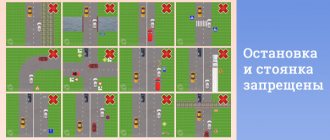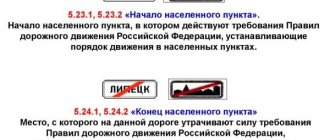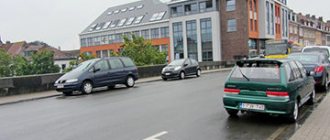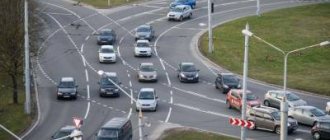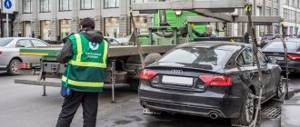Signs 5.16 - 5.18 “Bus (trolleybus), tram and taxi stop”
Signs 5.16 “Bus and (or) trolleybus stopping place”, 5.17 “Tram stopping place” and 5.18 “Taxi parking place” are used to designate stopping points of the corresponding types of route vehicles and passenger taxi parking.
Signs 5.16 “Bus and (or) trolleybus stopping place” are installed at the beginning of the landing area.
If there is a pavilion at a stopping point, then the stop sign can be installed on the pavilion above its closest edge in the direction of travel or on a separate support next to the pavilion.
When it is necessary to indicate the length of one or several stopping points located one after another, sign 5.16 “Bus and (or) trolleybus stopping place” is used with sign 8.2.1 “Validity area”. The sign is installed at the beginning of the first stopping point.
When tram tracks are located in the middle of the roadway (or to the left of a one-way roadway), sign 5.17 “Tram stopping place” is installed to the right of the roadway.
In some cases, when tram tracks are located in the middle of the roadway, the “Tram Stopping Place” sign is duplicated. Duplicate sign 5.17 is installed:
- if there is a raised landing area along the tram tracks - at the beginning of this area;
- on roads with two or more lanes in a given direction, if there is no landing pad - above the left lane.
It must be remembered that stopping or parking is prohibited closer than 15 meters from the stops of route vehicles or the parking of passenger taxis (clause 12.4 of the traffic rules). The starting point is the place where signs 5.16 - 5.18 are installed. This means 15 meters before and 15 meters after these signs, stopping and parking is prohibited.
Stopping is prohibited for any reason (except for stopping to pick up or disembark passengers, provided that this stop does not interfere with the movement of route vehicles or passenger taxis).
In places where route vehicles stop, turning around is still prohibited (clause 8.11 of the traffic rules).
The length of the route vehicle stop and taxi rank can be indicated by marking 1.17 (yellow zigzag). In this case, the prohibition on stopping (parking) and turning around applies throughout the entire yellow marking 1.17.
In populated areas, when driving past designated stops of route vehicles, you must also remember that clause 18.3 of the traffic rules obliges you to give way to trolleybuses and buses starting from the stop.
The issue of priority between route vehicles and other “non-route” traffic participants is discussed in the articles Driving past a stop of route vehicles and Priority of public transport.
Where to wait for the tram? (stops in Moscow)
Please tell me if there are rules for where to wait for the tram if the tram tracks are laid in the middle of the road, on a hill. An example is Budyonny Avenue in Moscow.
The fact is that I have one rule in my memory from the distant past, but in modern traffic rules and GOSTs I find another.
Rule in my memory
If the tram stop sign hangs above the road (above the roadway or above the rails), then you need to wait in the middle of the road, near the rails. If the sign hangs on the side of the road (on a pole or pavilion), then you need to wait on the side of the road, and only when the tram stops, go out onto the road to board. Here I call a sign a white sign with route numbers. It is not a road sign. What is this rule: popular rumor / used to exist / a glitch of my imagination?
In traffic rules today
For pedestrians: 4.8. Waiting for a route vehicle and a taxi is allowed only on landing platforms raised above the roadway, and if there are none, on the sidewalk or side of the road. In stopping places for route vehicles that are not equipped with raised landing platforms, it is allowed to enter the roadway to board the vehicle only after it has stopped. After disembarking, it is necessary to clear the roadway without delay. When moving through the roadway to or from the stopping point of a route vehicle, pedestrians must be guided by the requirements of paragraphs 4.4 - 4.7 of the Rules.
For drivers:
14.6. The driver must give way to pedestrians walking to or from a fixed-route vehicle standing at the stopping place (from the door side), if boarding and disembarking is carried out from the roadway or from a landing area located on it. Here it turns out that pedestrians are expected to wait for the tram at Budyonny They can do it in the middle of the road, on an elevated part of it, and on the side of the road. After the tram stops, you can go out onto the road from the side of the road and board the tram. When disembarking, immediately go to the side of the road. For the driver, this means that when the tram stops, you need to stop and let passengers pass. Although the rails are raised, you still need to stop. Do I understand this correctly, what do you think?
In GOST today
According to GOST R 52289-2004 (clause 5.6.23, p. 19),
5.6.23 Signs 5.16 “Bus and (or) trolleybus stopping place”, 5.17 “Tram stopping place” and 5.18 “Passenger taxi parking place” are used to designate stopping points of the corresponding types of route vehicles and parking for passenger taxis.
Signs must be double-sided. One-sided signs may be used outside populated areas on sections of roads with a dividing strip where there is no pedestrian traffic along the roads. Signs 5.16 are installed at the beginning of the landing area. If there is a pavilion at a stopping point, it is allowed to install signs on the pavilion above its nearest edge in the direction of travel or on an independent support.
Sign 5.17 is installed to the right of the roadway when tram tracks are located in the middle of the roadway or to the left of a one-way roadway.
Duplicate sign 5.17 is installed: - if there is a raised landing area located along the tram tracks - at the beginning of this area; - without a landing area on roads with two or more lanes in a given direction - above the left lane. If necessary, indicate the length of one or more located one after another at stopping points, it is allowed to use sign 5.16 with plate 8.2.1. The sign is installed at the beginning of the first stopping point. Information about routes is indicated in accordance with GOST 25869 (That GOST talks about white signs with route numbers and their intervals. But it no longer talks about drivers and pedestrians).
3.4 duplicate sign: A sign installed in the same cross-section of the road as the main sign, which serves to increase the reliability of the perception of information by traffic participants.
ru-pdd.livejournal.com
Signs 5.19.1, 5.19.2 “Pedestrian crossing”
Signs 5.19.1 and 5.19.2 “Pedestrian crossing” are used to designate places intended for pedestrians to cross the road.
Sign 5.19.1 is installed on the right of the road, sign 5.19.2 on the left. On roads with a dividing strip (lanes), signs 5.19.1 and 5.19.2 are installed on the dividing strip, respectively, to the right or left of each roadway.
Sign 5.19.1, which is installed to the right of the road, is placed on the near border of the crossing relative to approaching vehicles, sign 5.19.2 - on the far one. The width of the pedestrian crossing, incl. which does not have zebra markings, is located between the lines on which the signs are installed.
Signs at a marked pedestrian crossing (markings 1.14.1, 1.14.2) are installed at a distance of no more than 1 meter from the boundaries of the crossing (from the markings).
At intersections it happens that the border of the marked (zebra) crossing closest to the center of the intersection coincides with the edge of the roadway. In other words, the pedestrian crossing seems to go beyond the border of the intersection or pass along its edge.
In this case, “Pedestrian crossing” signs may be installed only at the far border of the crossing, i.e. at the entrance to the intersection. The transition boundary is determined by the edge of the applied marking 1.14.1 or 1.14.2 (zebra).
Turning, stopping and parking of vehicles is prohibited at pedestrian crossings.
It is not prohibited to make a U-turn before or after a pedestrian crossing, unless there are other restrictions for this maneuver (for example, a solid center line marking).
Stopping and parking of vehicles is also prohibited within 5 meters of a pedestrian crossing. Immediately after the crossing, this ban is lifted unless there are other restrictions for it (for example, signs prohibiting stopping or parking are installed).
Sign for bus and (or) trolleybus stop
The road sign “Bus and (or) trolleybus stop” is used to indicate public transport stops:
This sign is installed either at the beginning of the landing area or at the stop pavilion.
Let me remind you that paragraph 12.4 of the traffic rules prohibits stopping and parking of vehicles at a distance of less than 15 meters from the sign in question 5.16. An exception is a stop for boarding or disembarking passengers, which does not interfere with the movement of public transport.
For violating this clause of the rules, the driver will receive a fine of 1,000 rubles (3,000 rubles in Moscow and St. Petersburg). You can find out more about the amount of fines from the traffic police fines table.
In addition, according to paragraph 18.3 of the traffic rules in populated areas, drivers must give way to public transport that starts moving from the designated stopping place. For this violation, the driver will receive a warning or an administrative fine of 500 rubles.
A few more prohibitions related to stopping public transport: turning around (clause 8.11 of the traffic rules) and reversing (clause 8.12 of the traffic rules) are prohibited. The fine for these violations is provided for in Part 2 of Article 12.14 of the Code of Administrative Offenses and amounts to 500 rubles.
Sign 5.20 “Artificial hump”
Sign 5.20 “Artificial Roughness” is used to indicate the boundaries of an artificial roughness.
The sign is installed on the nearest border of an artificial hump or marking 1.25 (indicating a road unevenness) relative to approaching vehicles.
Often, together with sign 5.20, you can see the prohibitory sign 3.24 “Maximum speed limit”. The coverage area of sign 3.24 does NOT end beyond the road bump.
Usually in such cases (next to the artificial bump), the speed limit sign is installed together with plate 8.2.1 “Validity area”, which indicates the coverage area of the prohibition sign.
If sign 3.24 “Maximum speed limit”, installed next to an artificial hump, is used without sign 8.2.1 “Value area”, then its coverage area lasts until the nearest intersection, or to another sign 3.24 with a different speed value.
An artificial unevenness is, after all, a bump, albeit of artificial origin. It can be large or small in size (there is a standard, but it may not be followed). In any case, driving over any unevenness, we can safely say that the car’s suspension is “strained.” To learn how not to damage your suspension, see the article How to drive over road bumps.
Road sign 5.17 “Tram stopping place”
| A public transport stop is always a high-risk area. The tram stop is no exception. Firstly, the tram line often runs not at the edge of the road, but in the middle, therefore, passengers boarding and disembarking do not take place on the sidewalk, but directly on the roadway. Secondly, very often passengers, having got off the tram, decide to cross the road right at this point, without bothering to walk to the nearest pedestrian crossing. Thirdly, the tram itself limits visibility, and drivers of other vehicles never know in advance whether at one moment or another a desperate pedestrian will jump out from behind a tram standing at a stop. In order to maximize the safety of the tram stop area and, at the same time, inform passengers about it, it is marked with road sign 5.17 “Tram stop location”. This sign is usually installed in the middle of the zone allocated for stopping, and in cases where it is of sufficient length, the sign is duplicated. Sign 15.7 belongs to the group of signs of special requirements. It has a rectangular shape characteristic of this group of characters and a blue color of the main field. The silhouette of a tram is depicted in the center of the sign on a white background. The first thing a driver should do when he sees the “Tram Stopping Place” sign is to slow down and increase his alertness, preparing for the fact that at any second a pedestrian may appear in front of his hood. In addition, he must remember that in the area of sign 5.17, reversing, turning and parking are prohibited. But a short stop to board or disembark passengers is permitted, unless it creates an obstacle to disembarkation and alighting of tram passengers. And one more rule: if the tram tracks run in the middle of the roadway, vehicle drivers are required to stop and wait while the tram passengers disembark and embark. |
Signs 5.21 “Residential zone” and 5.22 “End of residential zone”
Sign 5.21 “Residential zone” is used to designate the territory (zone) within which the requirements of the Road Traffic Rules, which establish the procedure for traffic in residential zones, apply. Sign 5.21 is installed at all entrances to residential areas.
Sign 5.22 “End of residential area” is used, accordingly, to indicate the end of a residential area. The sign is installed at all exits from residential areas. It may be placed on the reverse side of sign 5.21.
The rules for driving in courtyards and in areas marked with “Residential Zone” signs can be found in the article Driving in courtyards and residential areas from the Basics of Safe Driving series.
A complete list of road signs with special requirements with brief comments (explanations) on the website is posted in Appendix 1 of the Traffic Regulations.
Navigation through a series of articles<< Signs “Start of lane” and “End of lane” Signs Beginning and End of a populated area >>
Tram station
This is a special organized place that is intended for boarding and disembarking people from public transport, in this case the tram. In addition to a sign indicating the tram stop, it is equipped with a canopy and benches. It may also contain a map of tram routes, schedules and numbers of cars stopping on it.
In large cities, outdoor advertising is a common attribute, and there may also be a ticket sales point. Stopping cars in such places is prohibited.



